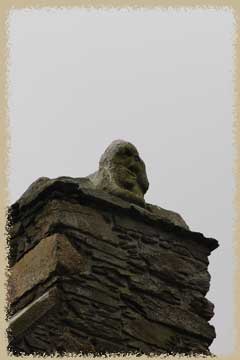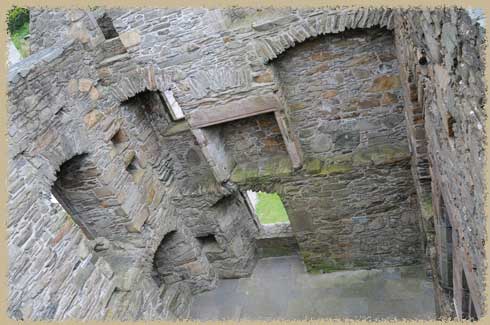Carsluith Castle
This caste is tucked between a house and a barbecue joint - I am conitualy surprised at how so many ruins are just squashed into housing developments

wedged between a house and a barbecue joint!
H2 level heading
The tower, built in 1586, is roughtly rectangular, with an added stair wing that rises higher than the original tower house. There is a caphouse on the top of the stair tower, used as a lookout point.
The older part of the tower has a rounded parapet on two corners, and a small courtyard surrounds the tower. Some of the wall is incorporated into the restaurant next door. The general architecture of the tower follows the standard layout: vaulted cellar, turnpike stair to the first floor halld, and private rooms above that. The door, also as usual, is in the angle of the tower and stair tower, where it is easily defended.

the small original tower of carsluith castle
The main tower is 9.8m x 7.6m and stands roughtly 10m tall. There are a number of windows in the main hall (the first storey) and a large fireplace. There is a third private room in the attic. Ther eis also a balcony on the third storey, reached by a now-blocked stair, and connecting to the other rooms in the private living chambers. T his might be the first castle we've seen that has a balcony (although the Earl's Palace on Orkney had some lovely bay wndows that were almost balcony-like.
Ownership
The lands here originally belonged to the Cairns family, and was sol to James Lindsey, the Chamberlain of Galloway, in 1460 - he built the original castle here, whihc may be incorporated into the later tower, which was built by Richard Brown in 1568.
One of his descendents, GIlbert, as the abbot of Sweetheart Abbey. He was imprisoned at Blackness Castle in 1605 for sheltering catholics. The castle remained in the family until 1748 when the Browns emigrated to India and abandoned it.


a small corbelled corner / a lion (?) on the top of the chimney

looking down at the fireplace and alcoves of the main hall


